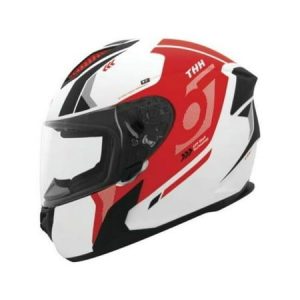Your motorcycle helmet is your primary defense against head injuries in the unfortunate event of an accident. But just like any other safety equipment, motorcycle helmets don’t last forever. Knowing how long a motorcycle helmet lasts and the factors that influence its lifespan is crucial for ensuring optimal protection on every ride.
This guide delves into the key aspects of motorcycle helmet lifespan, providing you with the information you need to make informed decisions about replacing your helmet. We’ll explore the average lifespan, factors that accelerate degradation, and the warning signs that indicate it’s time for a new lid.

The Average Lifespan of a Motorcycle Helmet
The average lifespan of a motorcycle helmet is generally considered to be around 5 to 7 years. However, this is just a ballpark figure, and the actual lifespan can vary depending on several factors, which we’ll discuss in detail later.
It’s important to remember that this estimated lifespan refers to the helmet’s safety capabilities. A helmet might look cosmetically fine after several years, but its protective properties may have diminished.
Factors Affecting Motorcycle Helmet Lifespan
Several factors can influence how long your motorcycle helmet remains safe and effective. Here are some key considerations:
- Frequency of Use: Helmets used daily will naturally degrade faster than those used occasionally. Sun exposure, sweat, and general wear and tear all contribute to a breakdown of the helmet’s materials.
- Exposure to Elements: Excessive sunlight, heat, and cold can accelerate the degradation of the helmet’s shell and liner. Leaving your helmet in direct sunlight for extended periods or storing it in extreme temperatures is not recommended.
- Chemicals and Cleaning Products: Harsh chemicals or abrasive cleaning products can damage the helmet’s outer shell and inner liner. Use mild soap and water for routine cleaning.

- Accidents or Impacts: Even minor drops or impacts can compromise the helmet’s structural integrity. A helmet that has been involved in an accident, even a seemingly minor one, should be replaced.
- Quality of Materials: Helmets made with higher-quality materials like high-density EPS foam and a strong outer shell will generally last longer than those made with cheaper materials.
Warning Signs Your Helmet Needs Replacing
While there’s no set expiration date for a motorcycle helmet, there are some telltale signs that indicate it’s time for a new one. Here’s what to watch out for:
- Visible Damage: Cracks, deep scratches, or gouges in the helmet’s shell compromise its ability to protect your head in a crash.
- Loose or Brittle Shell: If the helmet’s shell feels loose or brittle when pressed, it’s a strong indicator that the materials have degraded and the helmet needs to be replaced.
- Worn-Out Liner: The inner liner of your helmet is designed to absorb impact energy. Over time, the liner can become compressed and lose its effectiveness. Signs of a worn-out liner include excessive wear, tears, or a noticeable loss of padding.
- Difficulty Fastening the Chin Strap: If the chin strap becomes frayed, worn, or loses its ability to hold the helmet securely in place, it’s time for a new helmet.
- Changes in Fit: If your helmet no longer fits snugly and comfortably, it might not provide optimal protection in a crash. This could be due to a change in your head shape or degradation of the helmet’s liner materials.
Don’t Compromise on Safety: Invest in a New Helmet When Needed
Replacing your motorcycle helmet is an investment in your safety. If you notice any of the warning signs mentioned above, prioritize getting a new helmet. Here are some additional tips:

- Schedule Regular Inspections: Make it a habit to inspect your helmet for signs of damage or wear and tear at least once a year.
- Consider Your Riding Habits: If you’re a frequent rider, you might need to replace your helmet more often than someone who rides occasionally.
- Store Your Helmet Properly: When not in use, store your helmet in a cool, dry place away from direct sunlight and extreme temperatures. A helmet bag can offer additional protection from dust and scratches.
Finding the Right Replacement Helmet for You
With so many motorcycle helmets on the market, choosing the right replacement can feel overwhelming. Here are some key factors to consider:
- Safety Rating: Look for helmets that meet or exceed safety standards set by organizations like the Department of Transportation (DOT) or Snell Memorial Foundation.
- Fit: A proper fit is crucial for optimal safety and comfort. The helmet should fit snugly but comfortably around your head without any pressure points.
- Features: Consider the features that are important to you, such as a ventilation system, anti-fog visor, or internal sun visor.

- Style: Motorcycle helmets come in a wide variety of styles, from sporty full-face helmets to touring helmets with integrated sun visors. Choose a style that suits your riding preferences and personal taste.
- Price: Motorcycle helmets range in price from budget-friendly options to premium models with advanced features. Determine your budget and choose a helmet that offers the best value for your needs.
Invest in Your Safety: Shop for a High-Quality Helmet Today
Don’t wait for your current helmet to show signs of wear and tear before replacing it. Your motorcycle helmet is a vital piece of safety equipment, and prioritizing its condition is paramount for protecting yourself on the road. By following the tips and information outlined in this guide, you can make informed decisions about your helmet’s lifespan and ensure you’re riding with the best possible protection.
Visit your local motorcycle gear store or browse online retailers today to find a high-quality helmet that meets your needs and riding style. Invest in your safety – ride smart and ride protected!

Invest in Your Safety: Shop for a High-Quality Motorcycle Helmet Today
There’s no substitute for safety when it comes to motorcycle riding. By understanding motorcycle helmet lifespan and the factors that influence it, you can make informed decisions about replacing your helmet and ensure you’re always protected on the road.
Don’t wait until it’s too late! Visit your local motorcycle gear store or browse online retailers to find a high-quality helmet that meets your needs and riding style. Invest in your safety today and ride with confidence!


